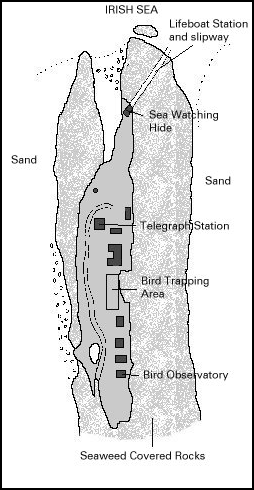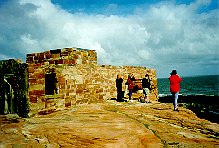Latest Bird Counts
Rarity News
Forthcoming Events
HILBRE ISLAND

The mouth of the Dee Estuary is very different from the inner reaches. Clean golden sands instead of mud and marsh, banks pounded by surf instead of calm water, but one thing above all that sets it apart are the Islands of Hilbre - Little Eye, Little Hilbre (or Middle Eye) and of course the main island of Hilbre itself. Seen from the top of Caldy Hill at high tide the three islands appear like ships steaming through the surf, catching the eye whenever they are in sight. A visit to these islands is a true wilderness experience and they are justly renowned for their birds.
The Birds
August and September are the prime months for a visit to Hilbre with numbers of waders building up well for the winter, and both land and sea migration well under way.
The birds of Hilbre fall roughly into four main categories:
Firstly, Hilbre specialities such as Purple Sandpipers. Although not rare, these birds are not particularly common and the seaweed covered rocks around Hilbre provide an ideal habitat.
Secondly the more common estuary birds - most importantly at high tide when vast flocks of Knot, Dunlin and Oystercatchers roost on the rocks which remain above the water.
Thirdly are the land migrants. During spring and autumn large falls of birds can be seen, particularly with the right weather conditions.
Lastly the sea-birds - terns, divers, auks, gannets, skuas and petrels to name but a few.
Highlights of the past twelve months
September 1997: Several days of north-west gales brought 140 Leach's Petrel on the 8th and 252 on the 9th. During these gales both Long-tailed and Pomarine Skuas where seen several times together with Sabine Gulls, Iceland Gull and a Storm Petrel.
October 1997:Three Pomarine Skuas on 10th and the Island saw it's first Pallas' Warbler on the 31st, this was the county's third record..
November 1997:The two days of 31st Oct and 1st Nov. were quite eventful with a Hen Harrier, Little Owl and 6 Whooper Swans.
A flock of Snow Buntings were present from 11th Nov. into the new year with a maximum of 35 in December. Great Skua seen on 30th. Nov.
March 1998: Notable sightings were 46 Little Gulls and a Lapland Bunting.
April 1998: April started well with the visit of Hilbre's second ever Red Kite on the 1st and an Osprey on the 12th. The spring migration was marked with the 2nd ever Woodlark, a Tree Pipit and Grasshopper Warblers among the usual numerous Willow Warblers. 5 Purple Sandpipers were still present on the 21st and another Lapland Bunting was seen on the 27th.
June 1998:127 Gannets on 14th June, good number considering the light breeze. Yellow-legged Gull on 20th. An early juvenile Wheatear seen on 27th and two Shags on same day.
July 1998: Tern numbers started to pick up with 6 Arctic Terns on the 4th. A strong north-westerly wind on the 11th brought in 45 Gannets, 12 Manx Shearwaters and 2 Storm Petrels. Storm Petrels were a feature this month with more being seen on the 13th, 14th and 18th.
Latest Sightings - thanks to Steve Williams of the Hilbre Bird Observatory for providing the info.
8th August - Little egret, only second record.
9th/10th August - Woodchat Shrike caught on Hilbre by John Gittins. This is the second record on the Island, the first also observed by John Gittins in 1958!
22nd August - Good day for Sea Watching - Manx shearwater 35, Balearic Shearwater 1 (first record), Gannet 50, Fulmar 3, Artic Skua 12, Long-Tailed Skua 1(very early record) and good numbers of terns including 80 Little Terns.
30th August - Tern numbers increased with about 125 Little Terns. 9 Artic Skuas. Two early Purple Sandpipers.
31st August - Good numbers of hirundines passing through, 600 House Martins and 250 Swallows in the morning alone. Spotted Redshank and Greenshank seen during the previous few days.


